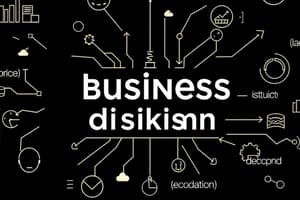Podcast
Questions and Answers
What is Data Licensing primarily about?
What is Data Licensing primarily about?
- Networking with a pyramid structured system
- Providing free information accompanied by advertisements
- Leveraging copyrighted databases to generate revenue (correct)
- Selling physical products online
Which e-commerce model involves no ownership of product or inventory?
Which e-commerce model involves no ownership of product or inventory?
- Affiliate Marketing
- Crowdsourcing
- Dropshipping (correct)
- Network Marketing
What differentiates High Touch from Low Touch?
What differentiates High Touch from Low Touch?
- The number of advertisements placed
- The geographical location of the business
- Type of products being sold
- Level of human interaction required (correct)
Which model runs on a commission basis and involves selling a company's products through a network of people?
Which model runs on a commission basis and involves selling a company's products through a network of people?
What is the main source of revenue for Blockchain businesses?
What is the main source of revenue for Blockchain businesses?
In which marketing model does the affiliate receive a commission for every sale referred?
In which marketing model does the affiliate receive a commission for every sale referred?
What does a business model explain?
What does a business model explain?
Which tool is used for presenting the key aspects of a business model?
Which tool is used for presenting the key aspects of a business model?
What is the purpose of the Business Model Canvass?
What is the purpose of the Business Model Canvass?
Which aspect of the business model focuses on establishing relationships with customers?
Which aspect of the business model focuses on establishing relationships with customers?
What is the main focus of Key Resources in a business model?
What is the main focus of Key Resources in a business model?
Which question does a typical business model aim to answer?
Which question does a typical business model aim to answer?
What type of auction involves buyers making repeated bids while being aware of other buyers' bids?
What type of auction involves buyers making repeated bids while being aware of other buyers' bids?
Which business model involves selling a high-margin product at a low price to boost sales of related low-margin products?
Which business model involves selling a high-margin product at a low price to boost sales of related low-margin products?
In which business model does the company offer services to both sides?
In which business model does the company offer services to both sides?
What is the main characteristic of Reversed Razor and Blades business model?
What is the main characteristic of Reversed Razor and Blades business model?
Which model involves selling a product or service for partial usage or separate parts?
Which model involves selling a product or service for partial usage or separate parts?
What is the core concept of the Hidden Revenue Business Model?
What is the core concept of the Hidden Revenue Business Model?
What is the key characteristic of a franchisee business model?
What is the key characteristic of a franchisee business model?
What is the defining feature of a brick-and-mortar business model?
What is the defining feature of a brick-and-mortar business model?
What is the key difference between a bricks-and-clicks and an e-commerce business model?
What is the key difference between a bricks-and-clicks and an e-commerce business model?
What is the core characteristic of a nickel-and-dime business model?
What is the core characteristic of a nickel-and-dime business model?
What is the key feature of a freemium business model?
What is the key feature of a freemium business model?
What is the defining characteristic of an aggregator business model?
What is the defining characteristic of an aggregator business model?
Which of the following is NOT a type of business organization mentioned?
Which of the following is NOT a type of business organization mentioned?
What is the primary characteristic that distinguishes a sole proprietorship?
What is the primary characteristic that distinguishes a sole proprietorship?
In a partnership, how are profits and losses shared?
In a partnership, how are profits and losses shared?
What is the primary purpose of a limited liability company?
What is the primary purpose of a limited liability company?
Which of the following best describes the term "business logic"?
Which of the following best describes the term "business logic"?
What is the primary purpose of logic, according to the text?
What is the primary purpose of logic, according to the text?
Flashcards are hidden until you start studying
Study Notes
Data Licensing
- Focuses on agreements defining how data can be used, accessed, and shared.
E-commerce Models
- Dropshipping: E-commerce model where the business doesn't own or hold inventory, selling products directly from suppliers to customers.
High Touch and Low Touch
- High Touch: Businesses provide personalized, human-intensive service and support.
- Low Touch: Businesses focus on self-service and automated processes, offering limited personal interaction.
Network Marketing/Multi-Level Marketing
- Commission-Based: Individuals earn commissions by selling a company's products and recruiting others to do the same.
Blockchain Business Revenue
- Primarily generated through transaction fees, charged for processing and verifying transactions on the blockchain.
Affiliate Marketing
- Commission structure: Affiliates earn a commission for each referral that leads to a sale.
Business Model Explained
- Outlines how a company creates, delivers, and captures value, describing its strategy for making profit.
Business Model Canvas
- A visual tool used to map out and communicate the essential components of a business model.
Business Model Canvas: Customer Relationships
- Focuses on how a business interacts with and manages its customer base.
Business Model Canvas: Key Resources
- Detail the assets and capabilities crucial to a company's success, like infrastructure, technology, or human capital.
Business Model Question
- How will the business create and capture value?
English Auction
- A type of auction where buyers submit bids in rounds, with each successive bid exceeding the previous one, and all bids are visible to everyone.
Loss Leader
- Selling a high-margin product at a low price to attract customers and boost sales of related low-margin products.
Two-Sided Marketplace
- Serving both sides of a transaction, connecting buyers and sellers, or providers and consumers.
Reversed Razor and Blades
- Selling a low-cost item (the razor) that requires a higher-priced consumable (the blades) for continued use.
Pay-Per-Use
- Offers a product or service for partial usage, like charging for minutes of phone calls or gigabytes of data use.
Hidden Revenue Business Model
- Generates revenue through sources that are not immediately apparent to customers, like selling user data for advertising purposes.
Franchisee Business Model
- Operates under a franchisor's established business model, brand, and systems, paying fees for the rights to use them.
Brick-and-Mortar
- Businesses with physical locations where customers can visit and purchase goods or services.
Bricks-and-Clicks vs. E-Commerce
- Bricks-and-Clicks: Combines online and physical store presence, offering a seamless shopping experience.
- E-Commerce: Exclusively conducts business online, with no physical stores.
Nickel-and-Dime Business Model
- Relies on generating small profits from a large volume of transactions, typically through high fees or charges on everyday items.
Freemium Business Model
- Offers a basic service for free, with premium features or services available for a fee.
Aggregator Business Model
- Brings together a vast selection of products or services from various providers, offering convenience and choice to customers.
Business Organization Types
- The text covers sole proprietorships, partnerships, and limited liability companies but does not mention other business organizations.
Sole Proprietorship
- Owned and operated by a single individual, who is personally responsible for all business debts and liabilities.
Partnership Profit Sharing
- Profits and losses are shared among partners according to their agreed-upon agreement, which may be based on contributions, time invested, or other factors.
Limited Liability Company (LLC)
- Provides limited liability protection to its owners, separating their personal assets from business liabilities, minimizing personal financial risk.
Business Logic
- Refers to the rules and processes that govern how a system or application behaves and operates, including how data is handled, operations are performed, and decisions are made.
Purpose of Logic
- Ensures that systems and applications function correctly and consistently, as well as providing a framework for automated reasoning and decision-making.
Studying That Suits You
Use AI to generate personalized quizzes and flashcards to suit your learning preferences.




